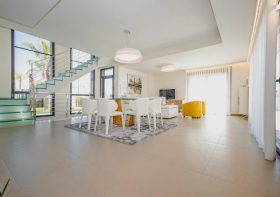Pendant light over dining table

The dining table is often the focal point of a dining room, and the right lighting can enhance the overall ambiance and functionality of the space. One popular and stylish choice for illuminating the dining area is a pendant light. Pendant lights not only provide adequate lighting but also serve as a decorative element, adding character and style to the room. In this article, we will explore the factors to consider when selecting a pendant light for your dining table and offer tips on installation and placement.
1. Consider the Size and Scale: The first consideration when choosing a pendant light for your dining table is the size and scale of the fixture. The light should be proportionate to the size of the table and the room. A small pendant light may get lost over a large dining table, while an oversized fixture can overwhelm a smaller table. Measure the width and length of your table to determine the appropriate size range for your pendant light.
2. Determine the Height: The height at which you hang the pendant light is crucial for both aesthetics and functionality. Ideally, the bottom of the pendant should be around 30 to 36 inches above the tabletop. This ensures that the light illuminates the entire table without obstructing the view across the table. Adjusting the height of the pendant can also create a more intimate or dramatic atmosphere, depending on your preference.
3. Match the Style: Pendant lights come in a variety of styles, from traditional to modern, industrial to rustic. Choose a style that complements the overall design of your dining room. Consider the existing furniture, color scheme, and architectural elements when making your selection. A well-chosen pendant light can tie together the various elements of the room and become a statement piece.
4. Coordinate with Room Decor: While it’s essential to consider the style of the pendant light, it’s equally important to coordinate it with the overall decor of the room. The finish and material of the pendant should complement other fixtures, such as chandeliers or wall sconces, creating a cohesive and harmonious look throughout the space.
5. Select the Right Light Bulb: The type of light bulb you choose can significantly impact the ambiance of the dining area. Consider the color temperature and brightness of the bulbs. Warm, soft lighting is often preferred for dining rooms as it creates a cozy and inviting atmosphere. Additionally, consider energy-efficient options, such as LED bulbs, which not only save energy but also have a longer lifespan.
6. Multiple Pendants or a Single Fixture: Depending on the size and shape of your dining table, you may opt for a single large pendant or a cluster of smaller ones. Multiple pendants can create a visually striking effect and distribute light more evenly across the table. However, it’s crucial to maintain proper spacing between the pendants to avoid overcrowding.
7. Installation and Wiring: Proper installation is key to ensuring both safety and functionality. If you’re replacing an existing light fixture, ensure that the new pendant is compatible with the existing wiring. If you’re installing a pendant for the first time, it’s advisable to consult a professional electrician. Additionally, consider installing a dimmer switch to have control over the intensity of the light, allowing you to create the desired mood for different occasions.
8. Budget Considerations: Pendant lights are available in a wide range of price points. Establish a budget before you start shopping to narrow down your options. While it’s tempting to splurge on a statement pendant, there are also many affordable options that offer style and functionality. Keep in mind that the cost may also include installation fees if you’re not comfortable doing it yourself.
9. Maintenance and Cleaning: Consider the practical aspects of maintaining your pendant light. Some designs may be more challenging to clean than others. Choose a fixture that aligns with your willingness and ability to perform regular maintenance. Dust and debris can accumulate on pendant lights, affecting both their appearance and the quality of light they emit.
10. Personal Taste and Expression: Ultimately, your choice of a pendant light should reflect your personal taste and style. Don’t be afraid to choose a unique or bold design that expresses your personality. Whether you prefer a sleek and minimalist look or a more ornate and decorative style, the pendant light can be a focal point that enhances the overall aesthetic of your dining room.
In conclusion, selecting the perfect pendant light for your dining table involves a thoughtful consideration of size, style, height, and practical considerations. By taking the time to assess these factors and align them with your personal preferences, you can illuminate your dining area with a fixture that not only provides the right amount of light but also adds a touch of style and sophistication to your home.




Leave a Reply